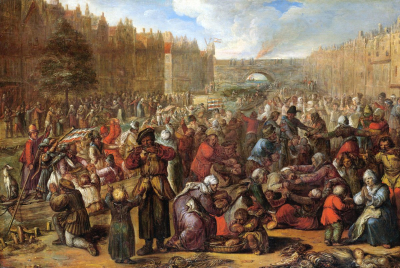The siege of Schenkenschans (30 July 1635 30 April 1636) was a major siege of the Eighty Years' War. In a successful campaign the Army of Flanders, commanded by Spanish general Cardinal-Infante Ferdinand of Austria, captured Schenkenschans along with a number of important towns, reversing recent Dutch gains and opening the Dutch Republic to a possible invasion. The Dutch Stadtholder, Fredrick Henry, pushed the republic's military efforts to their limit to recapture the fortress of Schenkenschans to counter the threat to the exposed Dutch heartland. He succeeded in doing so after a costly nine month siege.
The Eighty Years' War (Dutch: Tachtigjarige Oorlog; Spanish: Guerra de los Ochenta Años) or Dutch War of Independence (1568–1648) was a revolt of the Seventeen Provinces of what are today the Netherlands, Belgium and Luxembourg against Philip II of Spain, the sovereign of the Habsburg Netherlands. After the initial stages, Philip II deployed his armies and regained control over most of the rebelling provinces. Under the leadership of the exiled William the Silent, the northern provinces continued their resistance. They eventually were able to oust the Habsburg armies, and in 1581 they established the Republic of the Seven United Netherlands. The war continued in other areas, although the heartland of the republic was no longer threatened. This included the origins of the Dutch colonial empire, which began with Dutch attacks on Portugal's overseas territories. At the time, this was conceived as carrying the war with the Spanish Empire overseas due to Portugal and Spain's being in a dynastic union.
The Dutch Republic was recognised by Spain and the major European powers in 1609 at the start of the Twelve Years' Truce. Hostilities broke out again around 1619, as part of the broader Thirty Years' War. An end was reached in 1648 with the Peace of Münster (a treaty part of the Peace of Westphalia), when the Dutch Republic was definitively recognised as an independent country no longer part of the Holy Roman Empire. The Peace of Münster is sometimes considered the beginning of the Dutch Golden Age. Nevertheless, despite achieving independence, from the end of the war in 1648 there was considerable opposition to the Treaty of Münster within the States General of the Netherlands since it allowed Spain to retain the Southern Provinces and permitted religious toleration for Catholics.

1635Jul, 30
Eighty Years' War: The Siege of Schenkenschans begins; Frederick Henry, Prince of Orange, begins the recapture of the strategically important fortress from the Spanish Army.
Choose Another Date
Events on 1635
- 30May
Peace of Prague (1635)
Thirty Years' War: The Peace of Prague is signed. - 28Jul
Siege of Schenkenschans
In the Eighty Years' War the Spanish capture the strategic Dutch fortress of Schenkenschans. - 30Jul
Siege of Schenkenschans
Eighty Years' War: The Siege of Schenkenschans begins; Frederick Henry, Prince of Orange, begins the recapture of the strategically important fortress from the Spanish Army. - 9Oct
Roger Williams
Founder of Rhode Island Roger Williams is banished from the Massachusetts Bay Colony as a religious dissident after he speaks out against punishments for religious offenses and giving away Native American land. - 22Nov
Dutch pacification campaign on Formosa
Dutch colonial forces on Taiwan launch a pacification campaign against native villages, resulting in Dutch control of the middle and south of the island.

 English
English  español
español  français
français  português
português  русский
русский  العربية
العربية  简体中文
简体中文 